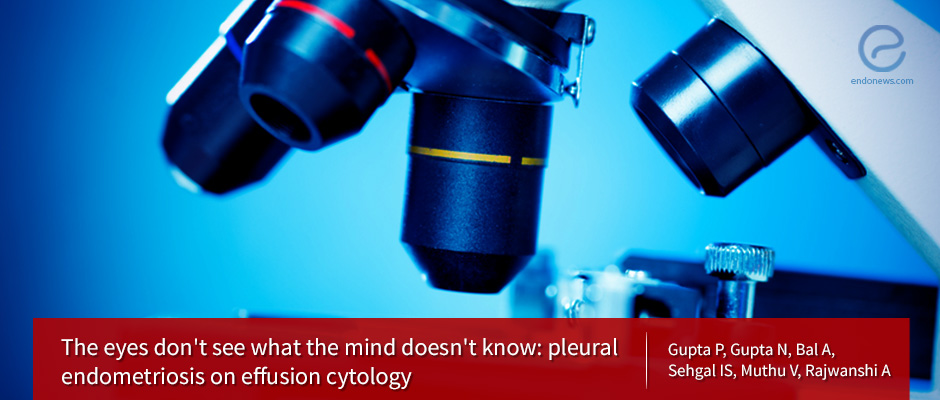Thoracic Endometriosis Syndrome (TES): Diagnosis by cytology of pleural effusion
Jul 27, 2018
Cytology of pleural effusion may assist in the diagnosis of thoracic endometriosis
Key Points
Highlights:
- Most common sites of endometriosis are the pelvic organs and tissues, including ovaries, fallopian tubes, uterosacral ligaments and the rectovaginal septum, extra-pelvic endometriosis is extremely rare and difficult to diagnose due to non-specific clinical presentations
- Thorax is the most common site of extrapelvic endometriosis that may result in catamenial (related to menstruation) pneumothorax, hemothorax, hemoptysis, lung nodules, isolated catamenial chest pain and catamenial pneumo-mediastinum in descending order. All these symptoms and findings constitute the “thoracic endometriosis syndrome” (TES)
- Establishing a clinical diagnosis of thoracic endometriosis is quite challenging and in fact, it is practically a diagnosis of exclusion
Importance:
- Clinical suspicion and awareness of the temporal association of the patient ’s symptoms with menses are crucial to establish a clinical diagnosis of TES. However, due to lack of adequate history in the majority of TES cases, a precise diagnosis can only be established by microscopic identification of endometrial tissue elements in specimens from pleural and/or lung as in this present case report
What's done here:
- The authors report a rare case of pleural endometriosis that could be diagnosed on pleural fluid cytology, an exceptionally rare event.
Lay Summary
Parikshaa Gupta and colleagues from Chandigarh, India report a case of thoracic endometriosis diagnosed primarily by pleural fluid cytology in a most recent article at Cytopathology.
A 33-year-old female presented with a long history of recurrent bouts of chest pain associated with a dry cough and breathlessness, with some of the episodes coinciding with her menses. Most of these episodes were self-limited and responded to oral analgesics. Additionally, she was being evaluated for primary infertility. Her elder sister had infertility also, related to pelvic endometriosis and treated as such ending up in successful conception.
Physical examination revealed reduced breath sounds on the right side of chest with a dull note on percussion. Chest X-ray and computed tomography (CT) of the thorax confirmed right-sided pleural effusion without any pleural nodules or mediastinal lymphadenopathy. Laboratory workup was within normal limits except for anemia. Pleural tap revealed hemorrhagic fluid with exudative nature having low adenosine deaminase levels (14 U/L). Cytological examination of the pleural fluid sediment and liquid-based cytology (SurePathTM) showed scattered cohesive, 3-dimensional clusters of epithelial cells. These tight clusters had a remarkable resemblance to the 3-D endometrial clusters which are commonly seen in cervical smears. Few hemosiderin-laden macrophages were also identified in a background of blood as a supportive finding also. Based on the clinical history and cytomorphological characteristics a diagnosis of pleural endometriosis was made. Subsequent thoracoscopic biopsy also confirmed this diagnosis. She was treated with monthly leuprolide (3.75 mg administered intramuscularly). At two months follow-up, there was no recurrence of chest pain, breathlessness and chest pain.
Extra-pelvic endometriosis is extremely rare and often hard to diagnose due to non-specific clinical presentations. Although the symptoms are often associated with menstruation, such an association is often ignored. Thorax is the most frequently involved extra-pelvic site. Thoracic endometriosis is characterized by the presence of functioning endometrial tissue within the pleura and/or lung parenchyma and/or the airways. It is associated with varied clinical presentations, the most common being a catamenial pneumothorax, hemothorax, hemoptysis, lung nodules, isolated catamenial chest pain and catamenial pneumo-mediastinum in descending order. These clinical presentations are named as thoracic endometriosis syndrome (TES).
The presented case highlights the utility of cytology as a simple, minimally invasive and cost-effective approach in the diagnosis of thoracic endometriosis. The cytopathologists need to be aware of the characteristic cytomorphology as appropriate history and careful cytological examination can help in achieving an accurate diagnosis of this rare entity.
Research Source: https://www.ncbi.nlm.nih.gov/pubmed/29904975
Thoracic endometriosis cytology pleural effusion minimally invasive cost effective

